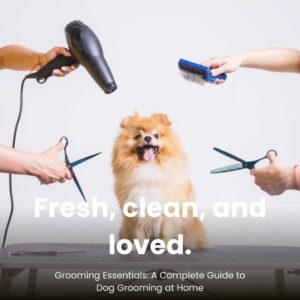Grooming Essentials: A Complete Guide to Dog Grooming at Home
 Grooming your dog at home is not only a great way to bond with your furry friend but also an essential part of their care routine. Regular grooming helps keep your dog’s coat and skin healthy, prevents matting, and allows you to check for any health issues. Here’s a complete guide to dog grooming at home:
Grooming your dog at home is not only a great way to bond with your furry friend but also an essential part of their care routine. Regular grooming helps keep your dog’s coat and skin healthy, prevents matting, and allows you to check for any health issues. Here’s a complete guide to dog grooming at home:
Gathering Supplies: Before you start grooming, gather all the necessary supplies. This includes a dog brush or comb suitable for your dog’s coat type, dog shampoo, towels, nail clippers, and ear cleaning solution.
Brushing: Start by brushing your dog’s coat to remove any loose hair and tangles. Brush in the direction of hair growth, and be gentle, especially around sensitive areas like the ears and belly.
Bathing: If your dog needs a bath, use a dog-specific shampoo and lukewarm water. Wet your dog thoroughly, apply shampoo, and lather gently. Rinse thoroughly to remove all shampoo residue.
Drying: Towel dry your dog after bathing, and then use a blow dryer on a low setting to dry their coat completely. Be careful not to use the dryer too close to your dog’s skin, as it can cause burns.
Nail Trimming: Use dog nail clippers to trim your dog’s nails. Be careful not to cut too close to the quick, as it can cause bleeding and pain. If you’re unsure, ask your veterinarian or a professional groomer for guidance.
Ear Cleaning: Use a dog-specific ear cleaning solution and a cotton ball to clean your dog’s ears. Gently wipe the outer ear, avoiding the ear canal. If you notice any signs of infection, such as redness or discharge, consult your veterinarian.
Dental Care: Brush your dog’s teeth regularly using a dog-specific toothbrush and toothpaste. This helps prevent dental issues such as tartar buildup and gum disease.
Trimming Hair: Depending on your dog’s breed, you may need to trim their hair regularly. Use scissors or clippers designed for pet grooming, and be careful around sensitive areas like the eyes and ears.
Checking for Fleas and Ticks: While grooming, check your dog for any signs of fleas and ticks. If you find any, consult your veterinarian for appropriate treatment.
Professional Grooming: If you’re not comfortable grooming your dog at home or if your dog has a complicated coat, consider taking them to a professional groomer for regular grooming sessions.
Regular grooming is an essential part of caring for your dog and can help keep them healthy and comfortable. By following this guide and establishing a grooming routine, you can ensure that your furry friend looks and feels their best.
